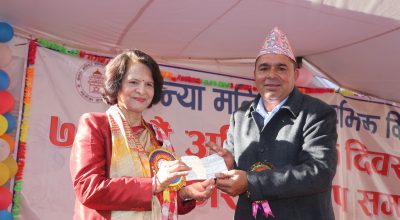
Kathmandu, Jan 30: The China proposed Belt and Road Initiative (BRI) has received a wide range of critical appreciations through developmental, academic and geo-political perspectives.
The BRI, which has generated both excitement and trepidation across the globe, as it affects not only a sizable number of nations but also socioeconomic and geopolitical situation. In Nepal, we have failed to finalize the projects to run under the BRI framework but Nepal’s commitment to this development endeavor is unstoppable. Through improved policy coordination, infrastructure connection, unhindered trade, financial integration, and interpersonal ties, the BRI seeks to advance win-win collaboration between China and the other signatory parties.
Against this backdrop, a book Belt and Road Initiative and South Asia edited by Dr Kalyan Raj Sharma which chronicles 11 articles of experts on Belt and Road Initiative has recently hit the bookstands. The book conducts a fair and thorough discussion as well as critical assessment of the BRI projects. Each chapter contains a wealth of information and offers guidance to the nations that have embraced BRI projects and others doing away with the BRI cooperation.
At time when the world has suffered a developmental setback and economic slowdown, this book comes up with some genuine feedback how Nepal and the South Asian nations at large can overcome their development bottlenecks and fulfill gaps in infrastructure, connectivity networks and other areas of cooperation. China is the second-largest economy and is one of the fastest-growing economies in the world that has achieved impressive results on poverty alleviation though multiple measures. This could be a lesson for the countries like Nepal that are reeling under crisis due to trap of low income resulting in the poverty of more than 15 per cent of the total population.
In the first chapter, Yin Xiangshuo puts his views on the topic ‘China’s Trade Imbalance with South Asian Nations, How Can the BRI help?’ Though the volume and scale of foreign trade between China and South Asian countries has increased since 1990s, the trade imbalance is a major problem and a better and close cooperation is required among the South Asian nations to fully reap the benefits of BRI– a better option to tackle the issue of trade imbalance and burgeoning trade deficit with China.
Likewise, in his chapter “The BRI and SDGs Nexus: Cooperation and Confrontation?, scholar Bhoj Raj Poudel argues that the BRI is dedicated to improving people-to-people communications, trade, finance, and infrastructure across nations and the Initiative offers substantial support and impetus for the implementation of the SDGs and is highly aligned with the 2030 Agenda in terms of visions, goals, and measures. Poudel further states that there are some initiatives undertaken at the regional level to develop cooperation so that the BI could be supportive to achieve SDGs by 2030.
China intends to set the pace for economic development in Asia through the BRI. China introduced BRI to South Asia while keeping all of its goals and objectives in mind. Economic sectors have undoubtedly grown in the countries that entered into agreements with China under BRI. South Asia is a “priority zone” in China’s Belt and Road Initiative, author Hina Aslam claims in her chapter. The BRI projects primarily benefit South Asian countries Pakistan and Bangladesh, but they can also create many benefits for the region as a whole.
According to Vaqar Ahmed’s “Evidence and Lessons from BRI: The Case of China-Pakistan Economic Corridor,” CPEC-related investments in Pakistan enhanced electricity production, logistics, and transportation. This allowed Pakistan to experience higher levels of growth, at least in the short term, and the development of additional capacities in some industrial sectors.
Nepal benefits from the Belt and Road Initiative as well. The scope and potential for Nepal-China cooperation in the BRI are also discussed in the book. The idea may aid in attracting significant Chinese investment, which will speed up social and economic development. Chinese and Nepali negotiators ought to reach a compromise that benefits both sides. The chapter recommends, among other things, that the political and social environment should stay stable for the benefit of bilateral economic cooperation.
The BRI projects are expected to be impacted by the post-pandemic world order. The COVID-19 Pandemic and BRI 2.0 by Partha S. Banerjee discusses the fresh potential for the BRI in the years after COVID-19. China may choose projects it would finance or co-finance and develop them under the BRI 2.0 with even more care, Banerjee claims adding that after the pandemic, emerging industries including the internet and smart economy, green energy, agriculture, and healthcare are likely to see an increase in BRI 2.0 financing.
Looking the BRI from the Southeast Asian perspective, Lao PDR signed BRI with China in 2016, and the projects such as Laos-China railway under BRI accelerated the economic development in the country. Meanwhile Malaysia considers that China has become more powerful and “assertive”, and actively promoting economic inducement via the BRI. Malaysia has taken China’s BRI project more positively and considers it to be too big and important for domestic development of Malaysia. The win-win framework remains to be a promising paradigm that signals positive engagements between China and the partner countries. The Philippine government directed by its national development vision and strategies has seen how the BRI could complement its actions.
In nutshell, the book Belt and Road Initiative and South Asia by Dr Sharma is a wonderful result of numerous researchers in South Asia and beyond that offers multiple recommendations for the policymakers, development partners and the government alike. Published by KW Publishers Pvt Ltd New Delhi, India, this book is a fantastic illustration of how academics from various nations along the Belt and Road in South and Southeast Asia collaborated. (RSS Nepal)
Mr Subedi is Senior Editor at National News Agency (RSS) of Nepal.
















